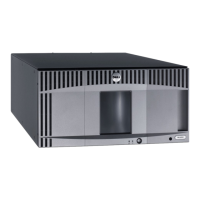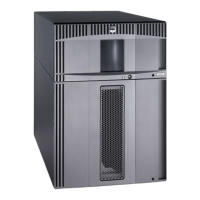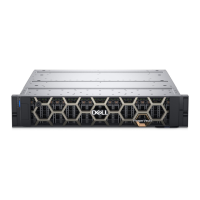Running Your Library
file:///T|/htdocs/stor-sys/ML6000/en/html/ch05.htm[9/17/2012 1:49:49 PM]
Taking a Tape Drive Online or Offline
There are two tape drive modes: online and offline.
• Online — Tape drive is available for use. This is the normal operating mode for the tape drive.
• Offline — Tape drive is offline to the host application and is not available for cartridge load and unload (move)
operations initiated by the host application, but it remains available for web client or operator panel initiated move
commands.
Note: If a cartridge is already in the tape drive when you take the tape drive offline, then the host can still read
and write data on the tape.
Some operations require that the tape drive be offline. You can take a tape drive offline rather than the entire library or
partition so as to minimize disruption of library operations.
This topic focuses on using the library user interface, not the host application, to change the tape drive mode. Using the
library to change tape drive mode may affect the host application. See your host application documentation for more
information.
Details on changing the tape drive mode include:
• The default tape drive mode is online.
• You can select only tape drives in partitions to which you have been given access.
• The Online/Offline buttons toggle between modes.
Note: If you change the mode of a control path tape drive to offline, a caution dialog appears asking you to confirm
the mode change. For information on control path tape drives, see Working With Control Paths.
The paths to open the appropriate screens are as follows:
• From the Web client, select Operations > Drive > Change Mode.
• From the operator panel, select Operations > Change Drive Mode.
For step-by-step procedures, see the library's online Help. To access the online Help system, click the Help icon at the top
right of the Web client or operator panel user interface.
About Cleaning Tape Drives
Library tape drives require occasional cleaning. Cleaning cartridges are used to remove accumulated residue from each tape
drive's read/write head.
The library supports two methods for cleaning tape drives with cleaning cartridges: AutoClean and Manual.
AutoClean — Configuring one or more dedicated cleaning slots automatically enables AutoClean. Cleaning cartridges are
stored in the designated cleaning slots. When a tape drive needs cleaning, it notifies the library, and the library automatically
cleans the tape drive using a cleaning cartridge loaded in a cleaning slot. Automatic cleaning is integrated into routine library
operations. The host application requests the library to move a tape cartridge. If the tape drive performing the operation
needs cleaning, the library will perform the move operation and then automatically clean the tape drive with a cleaning
cartridge before informing the host application that the move operation is complete.
When a cleaning cartridge has expired, a RAS ticket informs the user to export the expired tape from the library. If more
cleaning cartridges are present, the next cleaning cartridge will be used for the next cleaning request. If no more cleaning
cartridges are available, a RAS ticket will inform the user that the tape drive needs cleaning and that a cleaning tape needs to
be imported.
Only administrators can configure cleaning slots, thus enabling AutoClean. When AutoClean is enabled, the library allows you
to import and export cleaning media through the I/E Station.
For information on configuring cleaning slots, see
Configuring Cleaning Slots. For information on importing and exporting
cleaning media, see
Importing Cleaning Media and Exporting Cleaning Media.
Note: Cleaning slots are not visible to the host application. To choose host-based cleaning, do not configure any
cleaning slots, and configure your host application to manage cleaning tape drives. Configuring cleaning slots on the
library may affect the host application. See your host application documentation for information.

